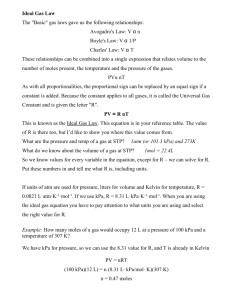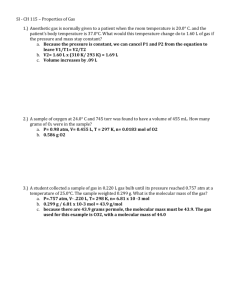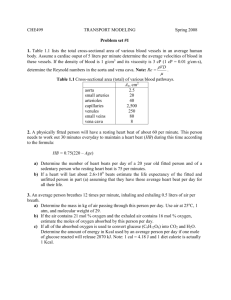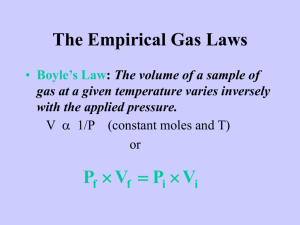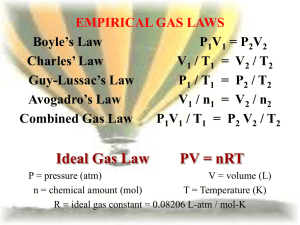PV = nRT: The Ideal Gas Law
advertisement
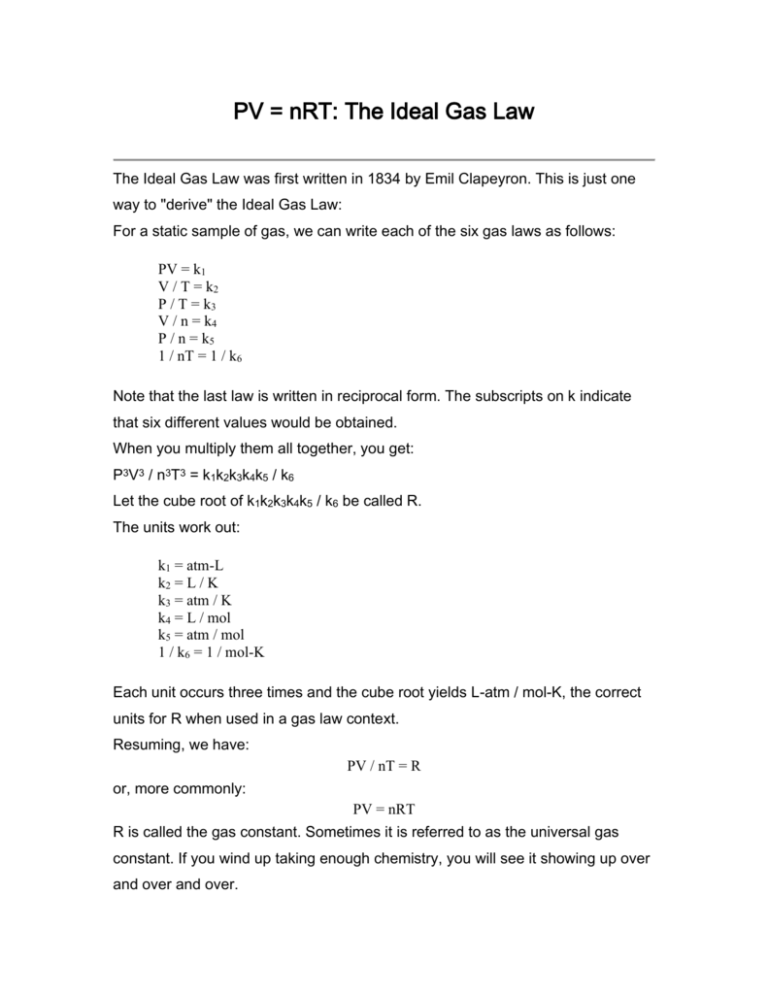
PV = nRT: The Ideal Gas Law The Ideal Gas Law was first written in 1834 by Emil Clapeyron. This is just one way to "derive" the Ideal Gas Law: For a static sample of gas, we can write each of the six gas laws as follows: PV = k1 V / T = k2 P / T = k3 V / n = k4 P / n = k5 1 / nT = 1 / k6 Note that the last law is written in reciprocal form. The subscripts on k indicate that six different values would be obtained. When you multiply them all together, you get: P3V3 / n3T3 = k1k2k3k4k5 / k6 Let the cube root of k1k2k3k4k5 / k6 be called R. The units work out: k1 = atm-L k2 = L / K k3 = atm / K k4 = L / mol k5 = atm / mol 1 / k6 = 1 / mol-K Each unit occurs three times and the cube root yields L-atm / mol-K, the correct units for R when used in a gas law context. Resuming, we have: PV / nT = R or, more commonly: PV = nRT R is called the gas constant. Sometimes it is referred to as the universal gas constant. If you wind up taking enough chemistry, you will see it showing up over and over and over. The Numerical Value for R R's value can be determined many ways. This is just one way: We will assume we have 1.000 mol of a gas at STP. The volume of this amount of gas under the conditions of STP is known to a high degree of precision. We will use the value of 22.414 L. By the way, 22.414 L at STP has a name. It is called molar volume. It is the volume of ANY ideal gas at standard temperature and pressure. Let's plug our numbers into the equation: (1.000 atm) (22.414 L) = (1.000 mol) (R) (273.15 K) Notice how atmospheres were used as well as the exact value for standard temperature. Solving for R gives 0.08206 L atm / mol K, when rounded to four significant figures. This is usually enough. Remember the value. You'll need it for problem solving. Notice the weird unit on R: say out loud "liter atmospheres per mole Kelvin." This is not the only value of R that can exist. It depends on which units you select. Those of you that take more chemistry than high school level will meet up with 8.3145 Joules per mole Kelvin, but that's for another time. The ChemTeam will only use the 0.08206 value in gas-related problems. Example #1 - A sample of dry gas weighing 2.1025 grams is found to occupy 2.850 L at 22.0°C and 740.0 mmHg. How many moles of the gas are present? Notice that the units for pressure MUST be in atm., so the 740.0 mm Hg must be converted first. 740.0 mm Hg ÷ 760.0 mm Hg/atm = 0.9737 atm However, the unrounded-off value should be used in the calculation just below. Now, plug into the equation: (0.9737 atm) (2.850 L) = (n) (0.08206 L atm / mol K) (295.0 K) and solve for n. Example #2 - Using the problem above, what is the molar mass of the gas? This is a very common use of this law and the odds are very good you will see this type of question on a test. The key is to remember the units on molar mass: grams per mole. We know from the problem statement that 2.1025 grams of the gas is involved and we also know how many moles that is. We know that from doing the calculation above and getting 0.1146 mol. So all we have to do is divide the grams of gas by how many moles it is: 2.1025 g ÷ 0.1146 mol = 18.34 g/mol Let's go over those steps for using the Ideal Gas Law to calculate the molar mass of the gas: 1) You have to know the grams of gas involved. Usually the problem will just give you the value, but not always. You might have to calculate it. 2) You are going to have to calculate the moles of gas. Use PV = nRT and solve for n. Make sure to use L, atm and K. 3) Divide grams by moles and there's your answer.



